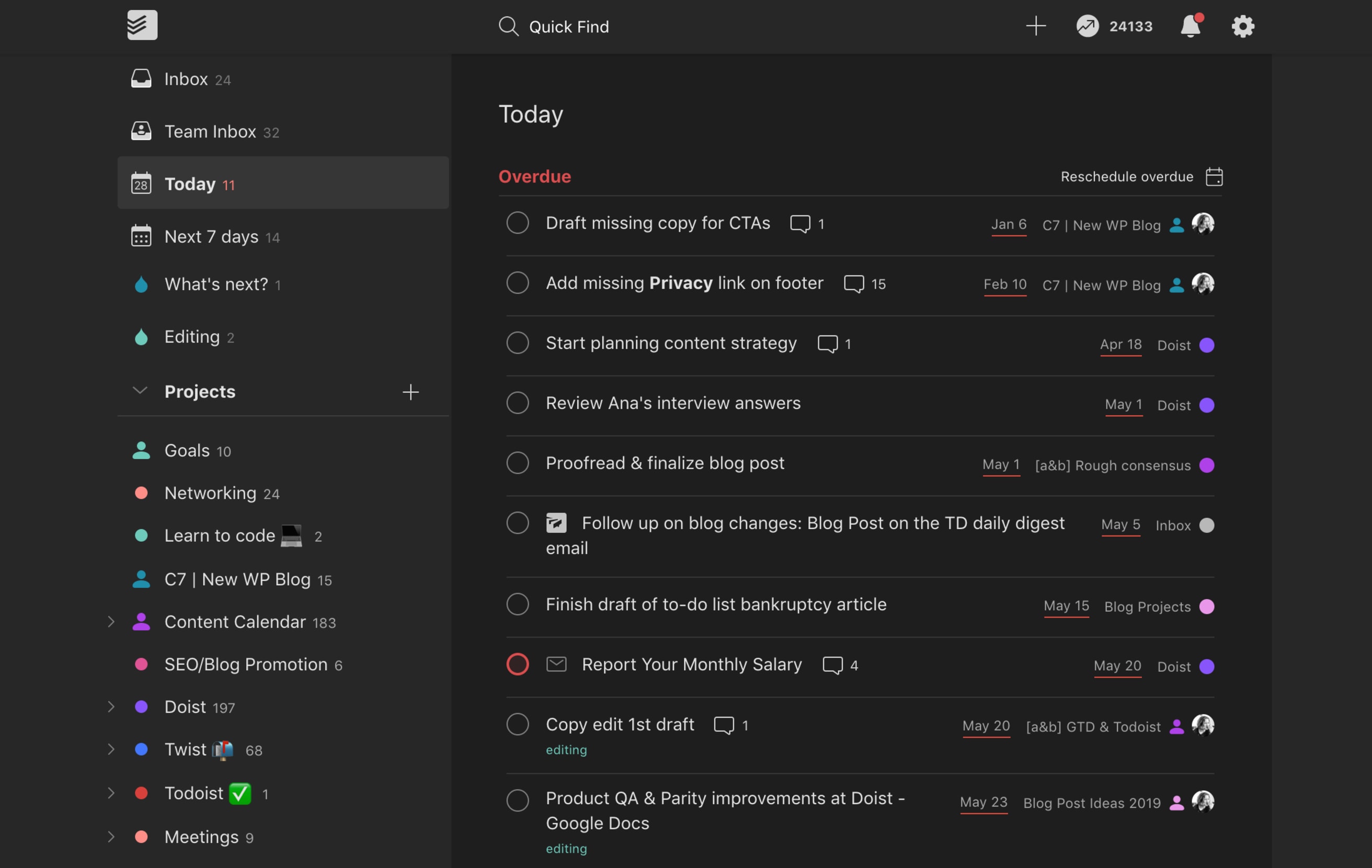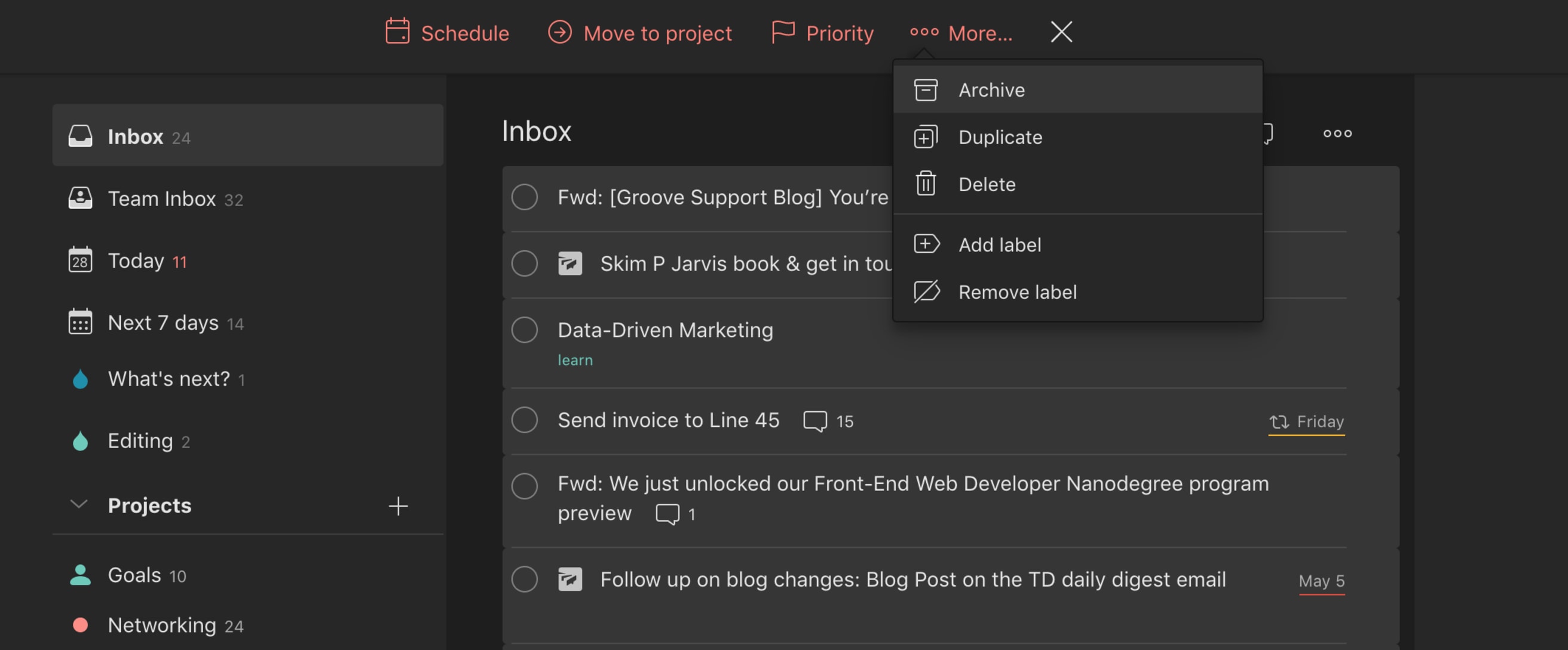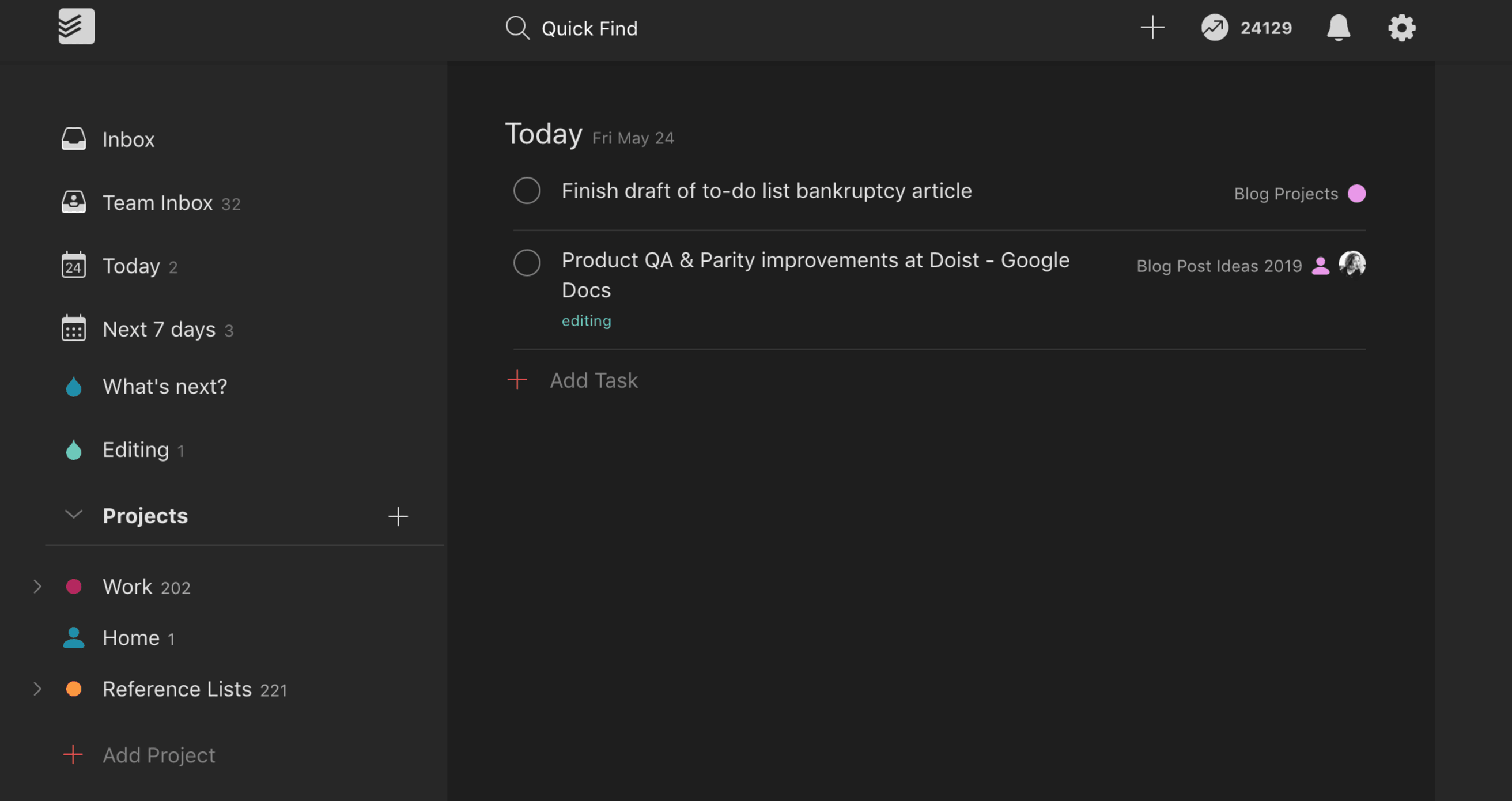Sometimes I fantasize about quitting my job. For the record (and the benefit of my boss who is probably reading this), I love my job. I love the work. I love the products. I love the people. I have zero intention of actually quitting.
But that doesn’t stop me from occasionally getting lost in the sweetest of daydreams in which all my unanswered emails, unfinished projects, and uncompleted tasks vanish from both my to-do list and my conscience in one fell swoop. All it would take is two little words, two tiny syllables, five measly letters. Saying them would be so much easier than facing down the 30 or so overdue tasks I usually have hanging around.
I assumed that quitting daydreams were a normal and inevitable part of modern-day work. But around the start of the new year, I came across an idea that was, at least for me, revolutionary: email bankruptcy. (Yes the concept has been around for over a decade now, I’m just very late to the party.) The thought of declaring email bankruptcy made me feel giddy, subversive, and more than a little anxious all at the same time. “You mean, I could just delete my emails? All of them? Without having responded to them?” It got me thinking that if fancy Washington Post editors can do it with their emails, why can’t I do it with my tasks? Just delete them. All of them. Without having done them. I could enjoy a clean slate and keep my job too.
Turns out I’m not the only one with the idea. A month ago, the universe sent me a sign in the form of a tweet from a Todoist user who had actually gone through with it.
According to his LinkedIn profile, Rick Galan has been the Head of Digital Marketing at Qualtrics – an experience research and analytics software company headquartered in Utah and Seattle – for the last 3 years and 7 months. On paper, he certainly looked successful. Yet here he was with a to-do list so out of control that he had decided to just give up and start fresh. Maybe his to-do list had become so overgrown because of his success, not in spite of it? Maybe that’s just me trying to rationalize my complete and utter failure to stay organized? Either way, I had to know his secret. Maybe hearing Rick’s story would be the motivation I needed to get over my guilt and FOMO and just hit reset on the whole thing. So we set up a time to talk.
If the thought of your to-do list makes you feel exhausted, maybe you’re burned out and really do need a hard reset in a new job. But maybe you, like me, just need to work up the guts to wipe the slate clean. This article is my way of giving myself – and hopefully you – permission to blow it all up and start over (with some very helpful advice from Rick along the way).
The problem with to-do lists
Rick, I would come to learn, is an avid follower of the GTD methodology. GTDers are the hardest of the hardcore productivity people. They literally own the phrase Getting Things DoneTM. They’re the friends you always invite on trips because you know they’ll do all the planning for you. GTD is presumably one of the reasons Rick is as successful as he is, but it was also the cause of his to-do list problems.
You see, rule #1 of GTD is to capture everything:
- All the emails that need answering
- All the delegated items that need to be followed up on
- All your ideas for new projects to start
Anything that takes up any amount of mental space, big or small, goes into the system – in this case Rick’s Todoist.
Now “capture everything” sounds like a solid enough rule to live by. Your brain just isn’t a safe place to keep things. It’s a leaky sieve that’s easily overwhelmed. It evolved to deal with one, maybe two, saber tooth tigers at a time. Not ten that you should actually have already dealt with yesterday and certainly not dozens more that you will need to deal with at very specific dates and/or times in the future. So GTD says to put all those saber tooth tigers on your to-do list instead.
You will actually end up doing a lot of the things you put in your GTD system for safe-keeping (that’s how you end up as Head of Digital Marketing). But even for the most successful people, there will be a lot of things that make it onto your to-do list that you’re never going to do – all those someday/maybe projects and aspirational recurring habits and things that seemed urgent enough to put a due date on in the moment but then the due date came and went without you doing them and nothing actually happened. That is your to-do list debt.

“Digital marketing professionals change jobs pretty frequently as a matter of course, right?,” Rick mused as we sat down to chat. "A two-to-three year stint is pretty typical for us, so I’ve always had a natural bankruptcy. But I've been here [at Qualtrics] now three-and-a-half years. I'm not going anywhere and my job has gotten more complicated over time with a lot more people on the team. I had built up a lot of noise in the system like 'Oh, that's a good idea. Throw it on the list.'"
Even the GTD faithful like Rick can fall behind on the sacred Weekly Review. And once you fall behind, things tend to snowball. Rick’s projects became so overgrown with irrelevant tasks, he stopped opening them and started living out of his Today and Next 7 Days views where he kept postponing the same group of tasks over and over again. (If you’re like me, you just let them pile up in overdue as if that will motivate you to actually do them.) Rick’s system stopped being a trusted place to align his day-to-day tasks with his bigger priorities. Which brings us to his first piece of advice for people who find themselves in a similar state.
Just give up.
When you’re that deep in to-do list debt, Rick found, trying to get organized incrementally is a losing battle. If you’re like Rick, your responsibilities, goals, and priorities have probably changed quite a bit since the last time you did a major reorganization of your task manager. Trying to clean up your tasks piecemeal without revisiting the whole system is like trying to fit square pegs in round holes. Rick says, and I’m paraphrasing here to extend a mediocre metaphor, throw the hole away, get a saw, and cut new holes that are custom fit for your pegs. In other words, the fastest, easiest, and more effective way to make your task manager useful again is to declare bankruptcy and start from scratch.
“For weeks, I was never able to make progress on cleaning up my lists,” says Rick. “I found myself simply not using the system because I couldn't dig into it. I tried to schedule time to review weekly and manage my tasks, but it wasn't getting there so, at some point, I'm just like, ‘You know what? I've done this with email before where you come back from vacation and you have 3000 things.’ It's like, ‘No.’ We're just going to say no.”
Most of us would benefit from a clean-up of our to-do lists. But how can you tell the difference between needing a small sweep of your task list versus starting from scratch? Here are a few factors to consider:
Why delete when you can archive?
I was surprised to discover that, in declaring to-do list bankruptcy, Rick didn’t actually delete a single task or project from his Todoist account. It turns out that archiving all your tasks and projects is mentally much easier than deleting. It’s like putting all the clothes you haven’t worn in years in a box in the basement instead of donating them. You could, theoretically, get them back if you missed them, but you won’t.
Yes, this does feel a little bit like cheating, but I’m not one for making things harder on myself than they have to be. In Rick’s brave words: “We're going to start from today and move on, archive all…so that’s what I did. I archived them all and sent them all to the abyss of project history.”
The important stuff will bubble back up.
This all sounded well and good so far, but I couldn’t shake the feeling that something cosmically bad would happen if I just got rid of everything. What if I accidentally archived something important?
Here’s the problem: I put things on my to-do list in the first place because I wanted to remember them. I want to think that I’ll come back to that idea I had for a new project two years ago. I want to believe that when I set a recurring daily task, I’ll actually follow through with it. I want, so badly, to accomplish all the things I put on my to-do lists on the due dates I set them for. And there are some important deadlines that I actually really do need to remember.
So I asked Rick, don’t you have any regrets? Didn’t you miss something important and look like an idiot in front of your coworkers? Aren’t you haunted by all those good ideas that will never come to pass?
Rick was much more zen about the whole thing: “Honestly, I haven’t missed anything important. The important stuff comes back or it's already in my head anyway. When I think about them, I put them back on my list.”
All those other things he put on his lists? He doesn’t miss them. “I was never going to come back to them anyway.”
Be less optimistic.
Rick now has a new list of projects that match up with his OKRs (Objectives and Key Results), his company’s system for setting quarterly goals. Post to-do list bankruptcy, he’s found his GTD approach is more realistic than it was in the past.
“I haven’t added any more of those ongoing recurring I-really-should-be-doing-this kind of stuff. I'm much less optimistic and much more realistic now. I've already been burned by the optimism, I guess.,” Rick reflects. “At this point, it's just things I know I need to do, and I'm much quicker to delete or check things off that I no longer need instead of keeping it and thinking, ‘Oh, well, maybe someday.’ I do have a someday/maybe list for ideas and stuff like that, but I keep it tucked away now so I can’t even see it.”
Maybe that’s the deeper lesson here – the source of our guilt and never-ending to-do lists isn’t really the external demands on our lives but our overly optimistic nature. Declaring to-do list bankruptcy is coming to terms with our human limitations. (As the GTD guru David Allen himself says “We can do anything, but we can’t do everything.”) It requires saying “no” to a lot of things and learning to ignore the ensuing FOMO. It’s letting go of the version of ourselves we wanted to be when we created all those projects, added all those tasks, and assigned ourselves all those deadlines in order to make room for a less stressed, more focused, and more realistic version of ourselves.
As of this writing, I have archived all my projects along with their tasks and multi-selected and archived all the tasks in my Inbox in one fell swoop. I was tempted several times to cheat and make exceptions, but I remembered Rick’s words – the important stuff will come back – and stayed the course.

(A disclaimer: I do have a lot of shared projects with the Doist team. I archived a lot of the ones that didn’t seem active anymore and, on Rick’s advice, tucked the others under a “Shared” parent project where they’re out of sight but I can always be called in when I’m needed. I also kept my recipes project.)
That was 5 days ago and so far so good. The universe continues to spin. I haven’t forgotten any important deadlines (yet). I haven’t been tempted to dig any old projects out of the archive. The projects I’ve since added reflect my priorities. If a new task doesn’t fit into one, I have to ask myself if it’s really worth doing. Opening my Todoist first thing in the morning is actually a calming experience – 'here are the limited number of things I need to focus on today' – rather than guilt-inducing – 'here are all the things I said I wanted to do and didn’t'.

Declaring to-do list bankruptcy isn’t a moral failing (though when you work with a bunch of Enlightened to-do list savants with Karma streaks of 365+ days, it can sometimes feel that way). It’s natural for your productivity system to need a refresh from time to time. It’s human to overestimate and procrastinate and get behind. I don’t think any to-do list app – even Todoist – can solve that problem for us. Declaring bankruptcy is an opportunity to let go of the guilt and make room for the things that spark joy (to borrow a phrase from Marie Kondo).
If this article resonated with you, I highly recommend giving to-do list bankruptcy a try. I won’t pretend archiving or deleting years-worth of tasks and projects is easy. But getting rid of your to-list debt and starting fresh is the most effective way I’ve found to replace your task list anxiety with a newfound enthusiasm to make progress on what’s most important to you – in work and in life. No quitting required.

